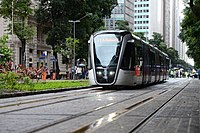Light rail
Light rail transit (LRT) is a form of passenger urban rail transit characterized by a combination of tram and rapid transit features. While its rolling stock is similar to that of a traditional tram, it operates at a higher capacity and speed and often on an exclusive right-of-way. In many cities, light rail transit systems more closely resemble, and are therefore indistinguishable from, traditional underground or at-grade subways and heavy-rail metros.
"LRT" redirects here. For other uses, see LRT (disambiguation).
There is no standard definition, but in the United States (where the terminology was devised in the 1970s from the engineering term light railway), light rail operates primarily along exclusive rights-of-way and uses either individual tramcars or multiple units coupled to form a train that has a lower capacity and speed than a long heavy-rail passenger train or rapid transit system.[1][2][3][4][5]
A few light rail networks tend to have characteristics closer to rapid transit or even commuter rail; some of these heavier rapid transit-like systems are referred to as light metros. Other light rail networks are tram-like and partially operate on streets.
Track gauge[edit]
Historically, the track gauge has had considerable variations, with narrow gauge common in many early systems. However, most light rail systems are now standard gauge.[10] Older standard-gauge vehicles could not negotiate sharp turns as easily as narrow-gauge ones, but modern light rail systems achieve tighter turning radii by using articulated cars. An important advantage of the standard gauge is that standard railway maintenance equipment can be used on it, rather than custom-built machinery. Using standard gauges also allows light rail vehicles to be conveniently moved around using the same tracks as freight railways. Additionally, wider gauges provide more floor clearance on low-floor trams that have constricted pedestrian areas at the wheels, which is especially important for wheelchair access, as narrower gauges can make it challenging or impossible to pass the tram's wheels. Furthermore, standard-gauge rolling stock can be switched between networks either temporarily or permanently, and both newly built and used standard-gauge rolling stock tends to be cheaper to buy, as more companies offer such vehicles.
Integration with bicycles[edit]
Light rail lines have various policies on bicycles.[48] Some fleets restrict bicycles on trains during peak hours. Some light rail systems, such as the St. Louis MetroLink, allow bicycles on the trains, but only in the rear sections of cars. Some light rail lines, like San Francisco's, allow only folding bicycles on board.[49] Some light rail systems, such as the MAX in Portland, have dedicated bike storage, either with dedicated hooks or spaces within train cars.[50] some systems, dedicated bike parking is available at select stations and others are integrated with local bike share systems.
Around the world, there are many extant tram and streetcar systems. Some date from the beginning of the 20th century or earlier such as Toronto streetcar system, but many of the original tram and streetcar systems were closed down in the mid-20th century, except for many Eastern European countries. Even though many systems closed down over the years, there are still several tram systems that have been operating much as they did when they were first built over a century ago. Some cities (such as Los Angeles and Jersey City) that once closed down their streetcar networks are now restoring, or have already rebuilt, at least some of their former streetcar/tram systems. Most light rail services are currently committed to articulated vehicles like modern LRVs, i.e. trams, except for large underground metro or rapid transit systems.
Several UK cities have substantial light rail networks including the Nottingham Express Transit, Sheffield Supertram, Manchester Metrolink.
A smaller network between Birmingham and The Black Country (West Midlands Metro), with plans to add 6 new lines and extend out to Stourbridge, Birmingham Airport & Walsall. Edinburgh Trams is also a single line route, currently looking to add other lines.[59]






